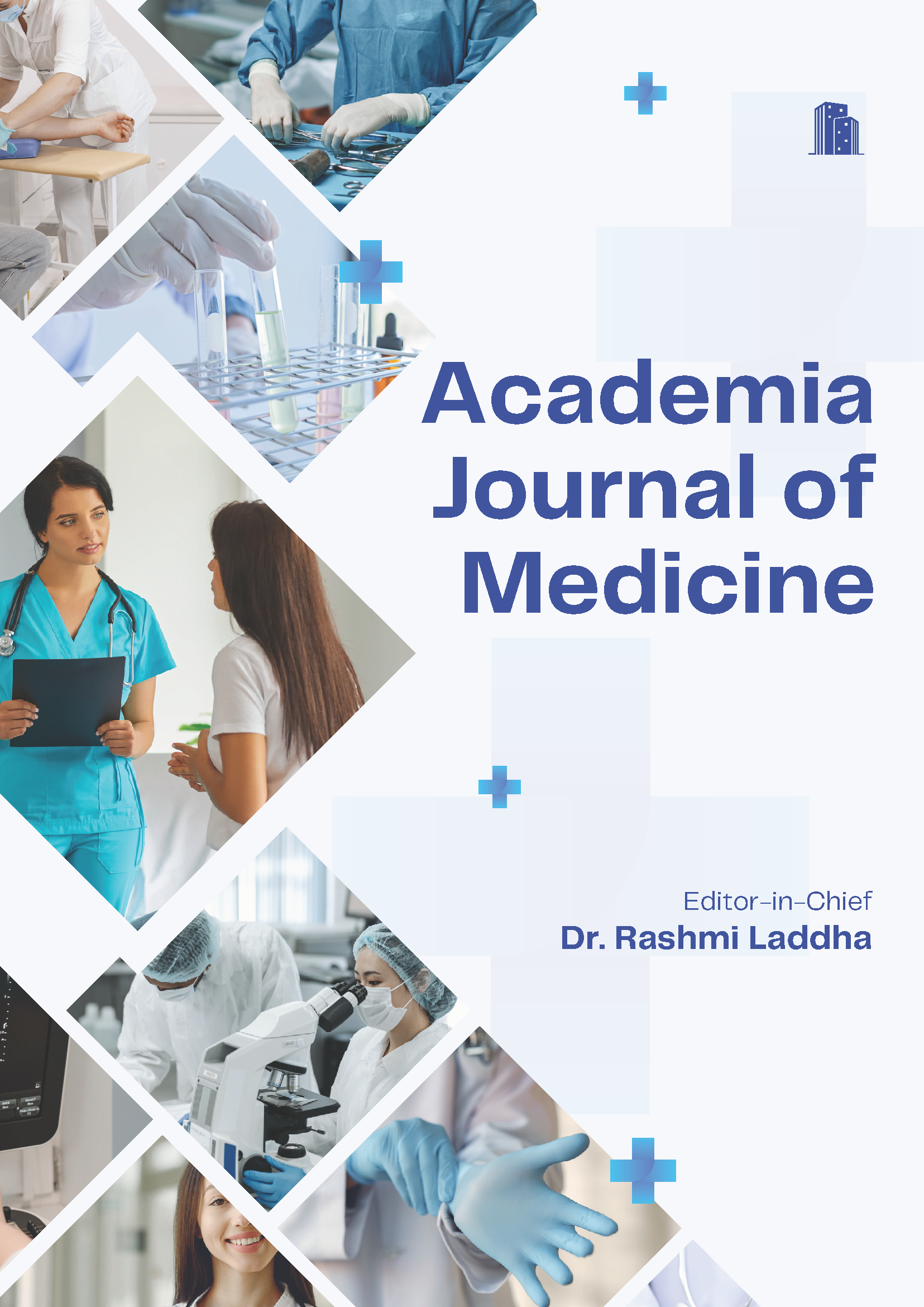Ischemia Modified Albumin in Early Diagnosis of Acute Coronary Syndromes
Keywords:
Acute coronary syndromes, Ischemic Modified Albumin, Cardiac MarkerAbstract
Background: Acute coronary syndromes (ACS) pose a diagnostic challenge in patients with unpredictable baseline ECGs or without evidence of myocardial necrosis. Its early diagnosis is of utmost importance as ACS has a high mortality. The present study was conducted to know the role of Ischemia Modified Albumin (IMA) as a Cardiac Marker in the early Diagnosis of ACS. Subjects and Methods: A cross-sectional study was conducted in 86 patients presenting with chest pain of less than 3hours. A 12-lead ECG was recorded, and a blood sample was taken for IMA and cardiac troponin T(cTnT). Results of all the parameters alone and in combination, were correlated with the final hospital diagnosis and analysed. Results: IMA was found to be abnormal among 72.1% of the patients. IMA had a sensitivity of 81.58% and a specificity of 83.33% which was found to be high when compared with other parameters. The combination of IMA, ECG, 2D ECHO, cTnT, and CKMB had a sensitivity of 100% and a specificity of 16.67%. Conclusion: The present study showed that IMA is a potential diagnostic biomarker for ACS. Further studies are required to support the present findings.
Downloads
References
1. Gaziano TA, Bitton A, Anand S, Abrahams-Gessel S, Murphy A. Growing Epidemic of Coronary Heart Disease in Low- and Middle-Income Countries. Curr Probl Cardiol. 2010;35(2):72– 115. Available from: https://dx.doi.org/10.1016/j.cpcardiol. 2009.10.002.
2. Lloyd-Jones DM, Larson MG, Beiser A, Levy D. Life time risk of developing coronary heart disease. Lancet. 1999;353(9147):89–92. Available from: https://dx.doi.org/10. 1016/s0140-6736(98)10279-9.
3. Kumar A, Cannon CP. Acute Coronary Syndromes: Diagnosis and Management, Part I. Mayo Clin Proc. 2009;84(10):917– 938. Available from: https://dx.doi.org/10.4065/84.10.917.
4. Pope JH, Aufderheide TP, Ruthazer R, Woolard RH, Feldman JA, Beshansky JR, et al. Missed Diagnoses of Acute Cardiac Ischemia in the Emergency Department. N Engl J Med. 2000;342(16):1163–1170. Available from: https://dx.doi.org/ 10.1056/nejm200004203421603.
5. Smith SW. T/QRS ratio best distinguishes ventricular aneurysm from anterior myocardial infarction. Am J Emerg Med. 2005;23:279–87. Available from: https://doi.org/10. 1016/j.ajem.2005.01.003.
6. Ohman EM, Armstrong PW, Christenson RH. Cardiac troponin T levels for risk stratification in acute myocardial ischemia. GUSTO IIA Investigators. N Engl J Med. 1996;335(18):1333–1374. Available from: https://doi.org/10. 1056/nejm199610313351801.
7. Antman EM, Tanasijevic MJ, Thompson B, Schactman M, McCabe CH, Cannon CP, et al. Cardiac-Specific Troponin I Levels to Predict the Risk of Mortality in Patients with Acute Coronary Syndromes. N Engl J Med. 1996;335(18):1342–1349. Available from: https://dx.doi.org/ 10.1056/nejm199610313351802.
8. Conor J, Mccann BM, Glaver. Novel biomarker in early diagnosis of acute myocardial infarction compared with cardiac troponin T. Eur Heart J. 2008;29(23):2843–2850. Available from: https://doi.org/10.1093/eurheartj/ehn363.
9. Tunstall-Pedoe H, Vanuzzo D, Hobbs M, Mähönen M, Cepaitis Z, Kuulasmaa K, et al. Estimation of contribution of changes in coronary care to improving survival, event rates, and coronary heart disease mortality across the WHO MONICA Project populations. Lancet. 2000;355(9205):688–700. Available from: https://dx.doi.org/10.1016/s0140-6736(99)11181-4.
10. Hajian-Tilaki K. Sample size estimation in diagnostic test studies of biomedical informatics. J Biomed Inform. 2014;48:193–204. Available from: https://dx.doi.org/10.1016/
j.jbi.2014.02.013.
11. Sinha MK, Roy D, Gaze DC. Role of “ischemia modified albumin”, a new biochemical marker of myocardial ischemia, in the early diagnosis of acute coronary syndromes. Emerg Med J. 2004;21:29–34. Available from: https://doi.org/10.1136/emj. 2003.006007.
12. Li CJ, Li JQ, Liang XF, Li XX, Cui JG, Yang ZJ, et al. Point of-care test of heart-type fatty acid-binding protein for the diagnosis of early acute myocardial infarction. Acta Pharmacol Sin. 2010;31(3):307–319. Available from: https://doi.org/10. 1038/aps.2010.2.
13. Gururajan P, Gurumurthy P, Nayar P, Rao GSN, Babu S, Cherian KM. Heart Fatty Acid Binding Protein (H-FABP) as a Diagnostic Biomarker in Patients with Acute Coronary Syndrome. Heart Lung Circ. 2010;19:660–664. Available from: https://dx.doi.org/10.1016/j.hlc.2010.06.665.
14. Anwaruddin S, Januzzi JL, Baggish AL, Lewandrowski EL, Lewandrowski KB. Ischemia-Modified Albumin Improves the Usefulness of Standard Cardiac Biomarkers for the Diagnosis of Myocardial Ischemia in the Emergency Department Setting. Am J Clin Pathol. 2005;123(1):140–145. Available from: https: //dx.doi.org/10.1309/4bctg5ucymqfwblr.
